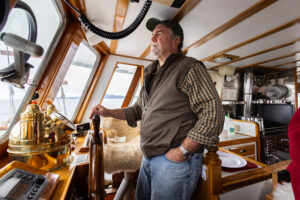
Boaters, or anyone who loves the water, appear to have a fascination with bridges. And when it’s decided to replace one, most folks are generally enthusiastic about the prospect. But a lawsuit filed against a plan to replace a bridge in North Carolina is pitting environmentalists against the state of North Carolinaand hopeful Outer Banks residents. Bridge closures in December for emergency repairs have only heated up the debate.
Times were good in the ’60s, when the Herbert C. Bonner Bridge was constructed across Oregon Inlet at North Carolina’s Outer Banks. In fact, times were good for all sorts of public highway projects after the passage of the Federal-Aid Highway Act in 1956. The act authorized the expenditure of $25 billion for the construction of interstate highways. Completed in 1963, the bridge was also built before the passage of the National Environmental Policy Act of 1969 (NEPA), which has specific requirements for projects that run through environmentally sensitive areas. But more on that later.

The $4.1 million bridge carrying NC 12 effectively opened up Hatteras Island to the outside world (and tourism), making the project an overwhelming success. Today, the bridge carries approximately two million vehicles per year. But 50 years of erosion and exposure have taken their toll. The bridge frequently closes for emergency repairs to its piers and supports (as recently as December 2013), which have been worn by aggressive currents. But this wasn’t news; the North Carolina Department of Transportation (NCDOT) knew this day was coming… and prepared for it.

As far back as 1989, NCDOT understood that a solution for replacing the bridge was needed. The tedious process of commissioning environmental impact, economic feasibility, design, and constructability studies started in 1990, and ran through July 2010, a period of 20 years. In July 2011, NCDOT secured funding and awarded a design-build contract for the replacement of the span. Construction was set to begin in early 2013 with completion slated for 2015. Sounds good in the neighborhood, right? Not so fast.
Before the ink had even dried on that design and contract, the Southern Environmental Law Center (SELC) filed a lawsuit on behalf of Defenders of Wildlife and the National Wildlife Refuge Association, alleging that the proposed bridge not only violated elements of NEPA because of the proximity of Pea National Wildlife Refuge, but North Carolina’s Coastal Area Management Act as well. “NCDOT’s plan ignores both the environmental impacts of the bridge and its responsibility to provide reliable, safe access across Oregon Inlet to Rodanthe on Hatteras Island for years to come,” said Julie Youngman, senior attorney at SELC.
Additionally, Defenders of Wildlife says that replacing just the bridge is shortsighted, citing the fact that NC 12 frequently washes out, requiring costly and frequent repairs. “Einstein defined insanity as doing the same thing over and over again and expecting different results. Replacing this bridge just isn’t the answer when even modest storms and tides now routinely swamp Highway 12,” says Jason Rylander of Defenders of Wildlife. One solution reached by the groups calls for the construction of a long bridge across Pamlico Sound that lands on a more stable area, bypassing the dynamic areas that often wash out. But the state says that such a bridge would cost as much as one billion dollars.
Needless to say, not many people who rely on the bridge to get back and forth from Hatteras Island, especially residents, are thrilled about the SELC lawsuit. Judge Louise Flanagan of the U.S. Eastern District Court heard arguments in September and she rejected the environmentalist’s claims. But SELC filed an appeal. A higher court asked NCDOT to go back to the environmental drawing board, so to say, by reversing the original decision. Whatever happens in this case, the court’s decisions will have far-reaching implications to the literally hundreds of crumbling ’60s-era bridges that cross our waterways. Stay tuned.






